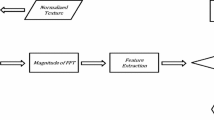Abstract
Polar complex exponential transform (PCET) is superior to pseudo Zernike moment-based method in terms of kernel generation, numerical stability and easier implementation. Their performance degrades under additive noise such as white Gaussian noise. Moreover, these methods show poor performance against directional information of texture. In this paper, a new rotation- and scale-invariant method for texture analysis using Radon transform and PCET for textured image is proposed. Scale and translation invariance is achieved by normalization process in Radon space, and rotation invariance is obtained by combining Radon transform with PCET. A k-nearest neighbor classifier is employed to classify the texture. To test and evaluate the proposed method, several sets of textures were experimented with different scaling, translation and rotation in different noisy conditions. The correct classification percentage is calculated under the varying standard deviation. Experimental results show preeminence of the proposed method as compared to the existing invariant texture analysis methods.
Similar content being viewed by others
References
Sarafrazi K., Yazdi M., Abedini M.J.: A new image texture segmentation based on contourlet fractal features. Arab. J. Sci. Eng. 38(12), 3437–3449 (2013)
Padma A., Sukanesh R.: Segmentation and classification of brain CT images using combined wavelet statistical texture features. Arab. J. Sci. Eng. 39(2), 767–776 (2014)
Lande, M.V.; Bhanodiya, P.; Jain, P.: An effective content-based image retrieval using color, texture and shape feature. In: Intelligent Computing, Networking, and Informatics. Springer, India, pp. 1163–1170 (2014). http://link.springer.com/chapter/10.1007%2F978-81-322-1665-0_119
Mosorov V., Tomczak L.: Image texture defect detection method using fuzzy C-means clustering for visual inspection systems. Arab. J. Sci. Eng. 39(4), 3013–3022 (2014)
Zhang J., Tan T.: Brief review of invariant texture analysis methods. Pattern Recognit. 35(3), 735–747 (2002)
Kashyap R.L., Khotanzad A.: A model-based method for rotation invariant texture classification. IEEE Trans. Pattern Anal. Mach. Intell. 4, 472–481 (1986)
Ojala, T.; Pietikainen, M.; Maenpaa, T.: Gray scale and rotation invariant texture classification with local binary patterns. In: Computer Vision-ECCV 2000, pp. 404–420. Springer, Berlin (2000)
Campisi P., Neri A., Panci G., Scarano G.: Robust rotation-invariant texture classification using a model based approach. IEEE Trans. Image Process. 13(6), 782–791 (2004)
Davis L.S.: Polarograms: a new tool for image texture analysis. Pattern Recogn. 13(3), 219–223 (1981)
Kashyap R.L., Khotanzad A.: A model-based method for rotation invariant texture classification. IEEE Trans. Pattern Anal. Mach. Intell. 4, 472–481 (1986)
Mao J., Jain A.K.: Texture classification and segmentation using multiresolution simultaneous autoregressive models. Pattern Recogn. 25(2), 173–188 (1992)
Chen J.-L., Kundu A.: Unsupervised texture segmentation using multichannel decomposition and hidden Markov models. IEEE Trans. Image Process. 4(5), 603–619 (1995)
Alapati, N.K.; Sanderson, A.C.: Texture classification using multi-resolution rotation-invariant operators. Cambridge Symposium. International Society for Optics and Photonics (1985)
Hongqing Z., Liu M., Ji H., Li Y.: Combined invariants to blur and rotation using Zernike moment descriptors. Pattern Anal. Appl. 13(5), 309–319 (2010)
Dai, X.; Liu, T.; Shu, H.; Luo, L.: Pseudo-Zernike moment invariants to blur degradation and their use in image recognition. Intell. Sci. In: Intelligent Science and Intelligent Data Engineering. Springer, Heidelberg, pp. 90–97 (2013). http://link.springer.com/chapter/10.1007%2F978-3-642-36669-7_12
Xiao B., Wang G.-Y.: Generic radial orthogonal moment invariants for invariant image recognition. J. Vis. Commun. Image Represent. 24(7), 1002–1008 (2013)
Wang X., Xiao B., Ma J.-F., Bi X.-L.: Scaling and rotation invariant analysis approach to object recognition based on Radon and Fourier–Mellin transforms. Pattern Recogn. 40(12), 3503–3508 (2007)
Li Y.: Reforming the theory of invariant moments for pattern recognition. Pattern Recogn. 25(7), 723–730 (1992)
Hosny K.M.: New set of Gegenbauer moment invariants for pattern recognition applications. Arab. J. Sci. Eng. 39(10), 7097–7107 (2014)
Estudillo-Romero A., Escalante-Ramirez B.: Rotation-invariant texture features from the steered Hermite transform. Pattern Recogn. Lett. 32(16), 2150–2162 (2011)
Sedghi T.: A fast and effective model for cyclic analysis and its application in classification. Arab. J. Sci. Eng. 38(4), 927–935 (2013)
Yap P.-T., Jiang X., Kot A.C.: Two-dimensional polar harmonic transforms for invariant image representation. IEEE Trans. Pattern Anal. Mach. Intell. 32(7), 1259–1270 (2010)
Noll R.J.: Zernike polynomials and atmospheric turbulence. JOsA 66(3), 207–211 (1976)
Chong C.-W., Raveendran P., Mukundan R.: The scale invariants of pseudo-Zernike moments. Pattern Anal. Appl. 6(3), 176–184 (2003)
Li L., Li S., Abraham A., Pan J.-S.: Geometrically invariant image watermarking using polar harmonic transforms. Inf. Sci. 199, 1–19 (2012)
Al-Shaykh O.K., Doherty J.F.: Invariant image analysis based on Radon transform and SVD. IEEE Trans. Circuits Syst. II Analog Digit. Signal Process. 43(2), 123–133 (1996)
Hiriyannaiah H.P., Ramakrishnan K.R.: Moments estimation in Radon space. Pattern Recogn. Lett. 15(3), 227–234 (1994)
Easton, R.L.: The Radon Transform. In: Fourier Methods in Imaging. Wiley, Chichester (2010). http://onlinelibrary.wiley.com/doi/10.1002/9780470660102.ch12/summary
Jafari-Khouzani K., Soltanian-Zadeh H.: Rotation-invariant multiresolution texture analysis using Radon and wavelet transforms. IEEE Trans. Image Process. 14(6), 783–795 (2005)
Cover T.M., Hart P.E.: Nearest neighbor pattern classification. IEEE Trans. Inf. Theory 13(1), 21–27 (1967)
Christian R.A., Patel D.A.: Potential of k-means clustering-based fuzzy logic for prediction of temperature in ambient atmosphere. Arab. J. Sci. Eng. 40(1), 227–234 (2015)
Tomašev, N.; Radovanović, M.; Mladenić, D.; Ivanović, M.: Hubness-based fuzzy measures for high-dimensional k-nearest neighbor classification. Int. J. Mach. Learn. Cybern. 5(3), 445–458 (2014)
Henley, W.E.; Hand, D.J.: A k-nearest-neighbour classifier for assessing consumer credit risk. Statistician 77–95 (1996). http://pages.ucsd.edu/~aronatas/project/academic/Nearest%20neighbor%20analysis%20in%20credit%20scoring.pdf
Brodatz P.T.: A Photographic Album for Artists and Designers. Dover, New York (1966)
Shao Z., Shu H., Wu J., Chen B., Coatrieux J.L.: Quaternion Bessel–Fourier moments and their invariant descriptors for object reconstruction and recognition. Pattern Recogn. 47(2), 603–611 (2014)
Mennesson J., Saint-Jean C., Mascarilla L.: Color Fourier–Mellin descriptors for image recognition. Pattern Recogn. Lett. 40, 27–35 (2014)
Guo L., Dai M., Zhu M.: Quaternion moment and its invariants for color object classification. Inf. Sci. 273, 132–143 (2014)
Jia X., Yang H., Ma S., Song D.: Quaternion higher-order spectra and their invariants for color image recognition. Opt. Lasers Eng. 57, 28–39 (2014)
Author information
Authors and Affiliations
Corresponding author
Rights and permissions
About this article
Cite this article
Singh, S.P., Urooj, S. Combined Rotation- and Scale-Invariant Texture Analysis Using Radon-Based Polar Complex Exponential Transform. Arab J Sci Eng 40, 2309–2322 (2015). https://doi.org/10.1007/s13369-015-1645-6
Received:
Accepted:
Published:
Issue Date:
DOI: https://doi.org/10.1007/s13369-015-1645-6




